 |
 |
Our enthusiastic and extremely knowledgeable perennials team is here to answer your questions and help you choose the best perennials for your situation. There’s always something in bloom for sun, shade, butterflies, birds or deer resistance as well as a variety of bulbs for your space.
Stroll through our time-tested favorites and introduce yourself to the newest varieties. We garden with perennials too; we love them and it shows!
|
39 found, showing page 1 of 3
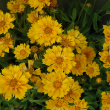
Height: 18 inches
Spread: 18 inches
Sunlight: full sun
Hardiness Zone: 4b
Other Names: Large Flowered Tickseed, Threadleaf
Coreopsis
Description:
Splendid fluted petals with cheery, daisy-like yellow flowers and a central gold disk; tolerant of pests and drier soils; thriving in sandy and rocky soils; coreopsis needs good drainage
Ornamental Features:
Jethro Tull Tickseed is smothered in stunning yellow daisy flowers with gold eyes and curiously fluted yellow tips at the ends of the stems from early summer to early fall. The flowers are excellent for cutting. Its ferny leaves remain emerald green in color throughout the season.
Landscape Attributes:
Jethro Tull Tickseed is an open herbaceous perennial with a mounded form. It brings an extremely fine and delicate texture to the garden composition and should be used to full effect.
This is a relatively low maintenance plant, and is best cleaned up in early spring before it resumes active growth for the season. It is a good choice for attracting butterflies to your yard, but is not particularly attractive to deer who tend to leave it alone in favor of tastier treats. It has no significant negative characteristics.
Jethro Tull Tickseed is recommended for the following landscape applications:
- Mass Planting
- Border Edging
- General Garden Use
- Container Planting
Planting & Growing:
Jethro Tull Tickseed will grow to be about 18 inches tall at maturity, with a spread of 18 inches. Its foliage tends to remain dense right to the ground, not requiring facer plants in front. It grows at a medium rate, and under ideal conditions can be expected to live for approximately 10 years. As an herbaceous perennial, this plant will usually die back to the crown each winter, and will regrow from the base each spring. Be careful not to disturb the crown in late winter when it may not be readily seen!
This plant should only be grown in full sunlight. It does best in average to evenly moist conditions, but will not tolerate standing water. It is not particular as to soil pH, but grows best in poor soils. It is somewhat tolerant of urban pollution. This particular variety is an interspecific hybrid. It can be propagated by division; however, as a cultivated variety, be aware that it may be subject to certain restrictions or prohibitions on propagation.
Jethro Tull Tickseed is a fine choice for the garden, but it is also a good selection for planting in outdoor pots and containers. It is often used as a 'filler' in the 'spiller-thriller-filler' container combination, providing a mass of flowers against which the thriller plants stand out. Note that when growing plants in outdoor containers and baskets, they may require more frequent waterings than they would in the yard or garden.

Height: 14 inches
Spread: 14 inches
Sunlight: full sun
Hardiness Zone: 4b
Group/Class: UpTick Series
Brand: Ball
Description:
A tidy, mounded variety, covered with striking, daisy-like yellow flowers with gold eyes and contrasting deep red-purple rings; tolerant of pests and drier soils; thriving in sandy and rocky soils; great as edging, or in containers; needs good drainage
Ornamental Features:
UpTick Cream and Red Tickseed is smothered in stunning yellow daisy flowers with gold eyes and a burgundy ring at the ends of the stems from late spring to early fall. The flowers are excellent for cutting. Its narrow leaves remain emerald green in color throughout the season.
Landscape Attributes:
UpTick Cream and Red Tickseed is an open herbaceous perennial with a mounded form. It brings an extremely fine and delicate texture to the garden composition and should be used to full effect.
This is a relatively low maintenance plant, and is best cleaned up in early spring before it resumes active growth for the season. It is a good choice for attracting bees and butterflies to your yard, but is not particularly attractive to deer who tend to leave it alone in favor of tastier treats. It has no significant negative characteristics.
UpTick Cream and Red Tickseed is recommended for the following landscape applications:
- Mass Planting
- Border Edging
- General Garden Use
- Container Planting
Planting & Growing:
UpTick Cream and Red Tickseed will grow to be about 12 inches tall at maturity, with a spread of 14 inches. Its foliage tends to remain dense right to the ground, not requiring facer plants in front. It grows at a medium rate, and under ideal conditions can be expected to live for approximately 10 years. As an herbaceous perennial, this plant will usually die back to the crown each winter, and will regrow from the base each spring. Be careful not to disturb the crown in late winter when it may not be readily seen!
This plant should only be grown in full sunlight. It does best in average to evenly moist conditions, but will not tolerate standing water. It is not particular as to soil pH, but grows best in poor soils. It is somewhat tolerant of urban pollution. This particular variety is an interspecific hybrid. It can be propagated by division; however, as a cultivated variety, be aware that it may be subject to certain restrictions or prohibitions on propagation.
UpTick Cream and Red Tickseed is a fine choice for the garden, but it is also a good selection for planting in outdoor pots and containers. It is often used as a 'filler' in the 'spiller-thriller-filler' container combination, providing a mass of flowers against which the thriller plants stand out. Note that when growing plants in outdoor containers and baskets, they may require more frequent waterings than they would in the yard or garden.
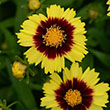
Height: 14 inches
Spread: 14 inches
Sunlight: full sun
Hardiness Zone: 4b
Group/Class: UpTick Series
Brand: Ball
Description:
A tidy, mounded variety, covered with striking, daisy-like yellow flowers with gold eyes and contrasting deep red rings; tolerant of pests and drier soils; thriving in sandy and rocky soils; great as edging, or in containers; needs good drainage
Ornamental Features:
UpTick Yellow and Red Tickseed is smothered in stunning yellow daisy flowers with gold eyes and a dark red ring at the ends of the stems from late spring to early fall. The flowers are excellent for cutting. Its narrow leaves remain emerald green in color throughout the season.
Landscape Attributes:
UpTick Yellow and Red Tickseed is an open herbaceous perennial with a mounded form. It brings an extremely fine and delicate texture to the garden composition and should be used to full effect.
This is a relatively low maintenance plant, and is best cleaned up in early spring before it resumes active growth for the season. It is a good choice for attracting bees and butterflies to your yard, but is not particularly attractive to deer who tend to leave it alone in favor of tastier treats. It has no significant negative characteristics.
UpTick Yellow and Red Tickseed is recommended for the following landscape applications:
- Mass Planting
- Border Edging
- General Garden Use
- Container Planting
Planting & Growing:
UpTick Yellow and Red Tickseed will grow to be about 12 inches tall at maturity, with a spread of 14 inches. Its foliage tends to remain dense right to the ground, not requiring facer plants in front. It grows at a medium rate, and under ideal conditions can be expected to live for approximately 10 years. As an herbaceous perennial, this plant will usually die back to the crown each winter, and will regrow from the base each spring. Be careful not to disturb the crown in late winter when it may not be readily seen!
This plant should only be grown in full sunlight. It does best in average to evenly moist conditions, but will not tolerate standing water. It is not particular as to soil pH, but grows best in poor soils. It is somewhat tolerant of urban pollution. This particular variety is an interspecific hybrid. It can be propagated by division; however, as a cultivated variety, be aware that it may be subject to certain restrictions or prohibitions on propagation.
UpTick Yellow and Red Tickseed is a fine choice for the garden, but it is also a good selection for planting in outdoor pots and containers. It is often used as a 'filler' in the 'spiller-thriller-filler' container combination, providing a mass of flowers against which the thriller plants stand out. Note that when growing plants in outdoor containers and baskets, they may require more frequent waterings than they would in the yard or garden.

Creamy white flowers with butter-yellow centers. Long bloom cycle. USDA 5-9
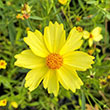
Large creamy yellow blooms. Medium textured foliage. USDA 5-9
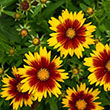
Height: 14 inches
Spread: 14 inches
Sunlight: full sun
Hardiness Zone: 4b
Group/Class: UpTick Series
Brand: Ball
Description:
A tidy, mounded variety, covered with striking, daisy-like yellow flowers with gold eyes and contrasting deep red-purple rings; tolerant of pests and drier soils; thriving in sandy and rocky soils; great as edging, or in containers; needs good drainage
Ornamental Features:
UpTick Gold and Bronze Tickseed is smothered in stunning yellow daisy flowers with orange overtones, gold eyes and a antique red ring at the ends of the stems from late spring to early fall. The flowers are excellent for cutting. Its narrow leaves remain emerald green in color throughout the season.
Landscape Attributes:
UpTick Gold and Bronze Tickseed is an open herbaceous perennial with a mounded form. It brings an extremely fine and delicate texture to the garden composition and should be used to full effect.
This is a relatively low maintenance plant, and is best cleaned up in early spring before it resumes active growth for the season. It is a good choice for attracting bees and butterflies to your yard, but is not particularly attractive to deer who tend to leave it alone in favor of tastier treats. It has no significant negative characteristics.
UpTick Gold and Bronze Tickseed is recommended for the following landscape applications:
- Mass Planting
- Border Edging
- General Garden Use
- Container Planting
Planting & Growing:
UpTick Gold and Bronze Tickseed will grow to be about 12 inches tall at maturity, with a spread of 14 inches. Its foliage tends to remain dense right to the ground, not requiring facer plants in front. It grows at a medium rate, and under ideal conditions can be expected to live for approximately 10 years. As an herbaceous perennial, this plant will usually die back to the crown each winter, and will regrow from the base each spring. Be careful not to disturb the crown in late winter when it may not be readily seen!
This plant should only be grown in full sunlight. It does best in average to evenly moist conditions, but will not tolerate standing water. It is not particular as to soil pH, but grows best in poor soils. It is somewhat tolerant of urban pollution. This particular variety is an interspecific hybrid. It can be propagated by division; however, as a cultivated variety, be aware that it may be subject to certain restrictions or prohibitions on propagation.
UpTick0 Gold and Bronze Tickseed is a fine choice for the garden, but it is also a good selection for planting in outdoor pots and containers. It is often used as a 'filler' in the 'spiller-thriller-filler' container combination, providing a mass of flowers against which the thriller plants stand out. Note that when growing plants in outdoor containers and baskets, they may require more frequent waterings than they would in the yard or garden.
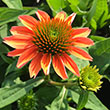
Plant Height: 16 inches
Flower Height: 24 inches
Spread: 18 inches
Sunlight: full sun
Hardiness Zone: 4a
Description:
A stunning first year flowering variety producing a mix of flower colors from rich purple, pink, red-orange, to yellow and white; attracts pollinators and feeds the birds in winter; use in naturalized areas with other native plants
Ornamental Features:
Cheyenne Spirit Coneflower has masses of beautiful lightly-scented orange daisy flowers with red overtones and coppery-bronze eyes at the ends of the stems from mid summer to mid fall, which are most effective when planted in groupings. The flowers are excellent for cutting. Its pointy leaves remain green in color throughout the season.
Landscape Attributes:
Cheyenne Spirit Coneflower is an herbaceous perennial with an upright spreading habit of growth. Its medium texture blends into the garden, but can always be balanced by a couple of finer or coarser plants for an effective composition.
This is a relatively low maintenance plant, and is best cleaned up in early spring before it resumes active growth for the season. It is a good choice for attracting butterflies to your yard, but is not particularly attractive to deer who tend to leave it alone in favor of tastier treats. It has no significant negative characteristics.
Cheyenne Spirit Coneflower is recommended for the following landscape applications:
- Mass Planting
- Rock/Alpine Gardens
- Border Edging
- General Garden Use
- Container Planting
Planting & Growing:
Cheyenne Spirit Coneflower will grow to be about 16 inches tall at maturity extending to 24 inches tall with the flowers, with a spread of 18 inches. Its foliage tends to remain dense right to the ground, not requiring facer plants in front. It grows at a medium rate, and under ideal conditions can be expected to live for approximately 10 years. As an herbaceous perennial, this plant will usually die back to the crown each winter, and will regrow from the base each spring. Be careful not to disturb the crown in late winter when it may not be readily seen!
This plant should only be grown in full sunlight. It is very adaptable to both dry and moist locations, and should do just fine under typical garden conditions. It is considered to be drought-tolerant, and thus makes an ideal choice for a low-water garden or xeriscape application. It is not particular as to soil type or pH. It is highly tolerant of urban pollution and will even thrive in inner city environments. This particular variety is an interspecific hybrid. It can be propagated by division; however, as a cultivated variety, be aware that it may be subject to certain restrictions or prohibitions on propagation.
Cheyenne Spirit Coneflower is a fine choice for the garden, but it is also a good selection for planting in outdoor pots and containers. With its upright habit of growth, it is best suited for use as a 'thriller' in the 'spiller-thriller-filler' container combination; plant it near the center of the pot, surrounded by smaller plants and those that spill over the edges. Note that when growing plants in outdoor containers and baskets, they may require more frequent waterings than they would in the yard or garden.
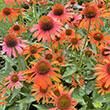
Tangerine blooms, Tolerates poor and dry soils, drought, and heat. USDA 5-9
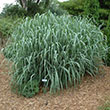
White, feathery plumes are tinged with purple. Rich-green foliage. USDA 5-9
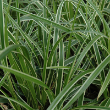
Height: 12 inches
Spread: 15 inches
Sunlight: full sun, partial shade, full shade
Hardiness Zone: 4b
Other Names: Creeping Japanese Sedge
Brand: Proven Winners
Description:
A low maintenance, cool weather ornamental grass featuring fast growing plants in the early spring and fall; beautiful narrow, arching foliage with forest green centers and creamy-white margins; well suited for containers, borders or garden beds
Ornamental Features:
Ice Dance Sedge is primarily valued in the garden for its cascading habit of growth. Its attractive grassy leaves are forest green in color with prominent white stripes. The foliage often turns brown in fall.
Landscape Attributes:
Ice Dance Sedge is an herbaceous evergreen perennial grass with a shapely form and gracefully arching stems. Its relatively fine texture sets it apart from other garden plants with less refined foliage.
This plant will require occasional maintenance and upkeep, and is best cleaned up in early spring before it resumes active growth for the season. Gardeners should be aware of the following characteristic(s) that may warrant special consideration:
- Spreading
Ice Dance Sedge is recommended for the following landscape applications:
- Mass Planting
- Border Edging
- General Garden Use
- Groundcover
- Naturalizing And Woodland Gardens
- Container Planting
Planting & Growing:
Ice Dance Sedge will grow to be about 12 inches tall at maturity, with a spread of 15 inches. Its foliage tends to remain dense right to the ground, not requiring facer plants in front. It grows at a medium rate, and under ideal conditions can be expected to live for approximately 10 years. As an evegreen perennial, this plant will typically keep its form and foliage year-round.
This plant performs well in both full sun and full shade. It prefers to grow in moist to wet soil, and will even tolerate some standing water. It is not particular as to soil type or pH. It is somewhat tolerant of urban pollution. This is a selected variety of a species not originally from North America. It can be propagated by division; however, as a cultivated variety, be aware that it may be subject to certain restrictions or prohibitions on propagation.
Ice Dance Sedge is a fine choice for the garden, but it is also a good selection for planting in outdoor pots and containers. It is often used as a 'filler' in the 'spiller-thriller-filler' container combination, providing a canvas of foliage against which the thriller plants stand out. Note that when growing plants in outdoor containers and baskets, they may require more frequent waterings than they would in the yard or garden.
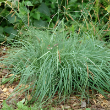
Height: 18 inches
Spread: 18 inches
Sunlight: partial shade, full shade
Hardiness Zone: 4a
Other Names: Carex glauca
Description:
A vigorous sedge that can grow in very diverse habitats; a tall, upright cultivar with attractive blue-green foliage; great in full sun or under the shade of large trees; suitable for rock gardens or as a groundcover but must have sufficient water
Ornamental Features:
Blue Zinger Blue Sedge is primarily valued in the garden for its interestingly mounded form. Its attractive grassy leaves remain bluish-green in color with showy silvery blue variegation throughout the year.
Landscape Attributes:
Blue Zinger Blue Sedge is a dense herbaceous evergreen perennial grass with a mounded form. It brings an extremely fine and delicate texture to the garden composition and should be used to full effect.
This is a relatively low maintenance plant, and is best cleaned up in early spring before it resumes active growth for the season. It has no significant negative characteristics.
Blue Zinger Blue Sedge is recommended for the following landscape applications:
- Mass Planting
- Border Edging
- General Garden Use
- Groundcover
Planting & Growing:
Blue Zinger Blue Sedge will grow to be about 18 inches tall at maturity, with a spread of 18 inches. Its foliage tends to remain dense right to the ground, not requiring facer plants in front. It grows at a slow rate, and under ideal conditions can be expected to live for approximately 10 years. As an evegreen perennial, this plant will typically keep its form and foliage year-round.
This plant does best in partial shade to shade. It is quite adaptable, prefering to grow in average to wet conditions, and will even tolerate some standing water. It is not particular as to soil type or pH. It is somewhat tolerant of urban pollution. Consider applying a thick mulch around the root zone in both summer and winter to conserve soil moisture and protect it in exposed locations or colder microclimates. This is a selected variety of a species not originally from North America. It can be propagated by division; however, as a cultivated variety, be aware that it may be subject to certain restrictions or prohibitions on propagation.
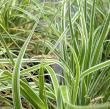
Silver margin. Evergreen. Tolerates heavy shade & moist soils. USDA 5-9
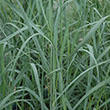
Blue-green foliage with feathery, pinkish-white plumes in summer. Strong, upright habit. USDA 5-9
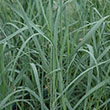
Blue-green foliage with feathery, pinkish-white plumes in summer. Strong, upright habit. USDA 5-9

Height: 16 inches
Spread: 16 inches
Sunlight: full sun, partial shade, full shade
Hardiness Zone: 4b
Other Names: C. hachijoensis
Group/Class: EverColor Series
Description:
A vigorous, mound forming evergreen plant with striking deep green foliage, edged in silvery white; makes quite a statement as a container planting or as an accent in the border or as a mass groundcover
Ornamental Features:
EverColor Everest Japanese Sedge is primarily valued in the garden for its cascading habit of growth. Its attractive grassy leaves are dark green in color with distinctive white edges. The foliage often turns brown in fall.
Landscape Attributes:
EverColor Everest Japanese Sedge is an herbaceous evergreen perennial grass with a shapely form and gracefully arching stems. It brings an extremely fine and delicate texture to the garden composition and should be used to full effect.
This is a relatively low maintenance plant, and is best cleaned up in early spring before it resumes active growth for the season. It has no significant negative characteristics.
EverColor Everest Japanese Sedge is recommended for the following landscape applications:
- Mass Planting
- Border Edging
- General Garden Use
- Groundcover
- Naturalizing And Woodland Gardens
- Container Planting
Planting & Growing:
EverColor Everest Japanese Sedge will grow to be about 16 inches tall at maturity, with a spread of 16 inches. Its foliage tends to remain dense right to the ground, not requiring facer plants in front. It grows at a medium rate, and under ideal conditions can be expected to live for approximately 10 years. As an evegreen perennial, this plant will typically keep its form and foliage year-round.
This plant performs well in both full sun and full shade. It prefers to grow in average to moist conditions, and shouldn't be allowed to dry out. It is not particular as to soil type or pH. It is somewhat tolerant of urban pollution. Consider applying a thick mulch around the root zone in both summer and winter to conserve soil moisture and protect it in exposed locations or colder microclimates. This is a selected variety of a species not originally from North America. It can be propagated by division; however, as a cultivated variety, be aware that it may be subject to certain restrictions or prohibitions on propagation.
EverColor Everest Japanese Sedge is a fine choice for the garden, but it is also a good selection for planting in outdoor pots and containers. It is often used as a 'filler' in the 'spiller-thriller-filler' container combination, providing a canvas of foliage against which the thriller plants stand out. Note that when growing plants in outdoor containers and baskets, they may require more frequent waterings than they would in the yard or garden.
39 found, showing page 1 of 3














